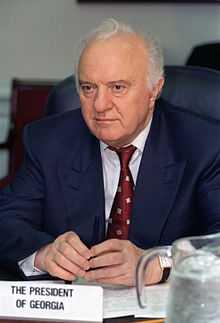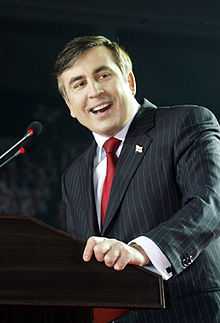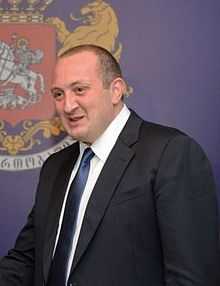President of Georgia
| President of Georgia საქართველოს პრეზიდენტი | |
|---|---|
|
Presidential Standard | |
| Appointer | Direct popular vote |
| Term length | Five years, renewable once, consecutively |
| Inaugural holder | Zviad Gamsakhurdia |
| Formation | 14 April 1991 |
| Website | Official website |
 |
| This article is part of a series on the politics and government of Georgia |
|
|
Legislature
|
|
Judiciary |
|
Related topics
|
|
Politics portal |
The President of Georgia (Georgian: საქართველოს პრეზიდენტი, sakartvelos prezidenti) is the head of state, supreme commander-in-chief and holder of the highest office within the Government of Georgia. Executive power is split between the President and the Prime Minister, who is the head of government. The office was first introduced by the Supreme Council of the Republic of Georgia on 14 April 1991, five days after Georgia's declaration of independence from the Soviet Union.[1] The President serves a five-year term. The incumbent is Giorgi Margvelashvili, who was sworn in on 17 November 2013.
Constitutional powers and duties
The President of Georgia is Head of State and was formerly the head of the executive branch, prior to 2013. The President directs and implements foreign policy, ensures the unity and territorial integrity of the country, and supervises the activities of state bodies in accordance, with the Constitution. The President is the supreme representative of Georgia in foreign relations.[2]
The President of Georgia is elected on the basis of universal, equal and direct suffrage by secret ballot, for a period of five years. The President may not be elected for more than two consecutive terms. Any citizen of Georgia who has the right to vote and who has attained the age of 35 years and lived in Georgia for no less than 15 years, is eligible to be elected President. The President of Georgia shall not have the right to hold any other position except for a party position, engage in entrepreneurial activity, receive salary or another permanent remuneration for any other activity.[2]
The President of Georgia concludes international treaties and agreements and conducts negotiations with foreign states; with the consent of Parliament, appoints and dismisses Georgian ambassadors and other diplomatic representatives; receives the credentials of ambassadors and other diplomatic representatives of foreign states and international organizations; declares a martial law and state of emergency; with the consent of Parliament has the right to halt the activities of representative bodies of self-government or territorial units as well as of state bodies; signs and promulgates laws; has the right to dissolve Parliament under certain conditions set by the Constitution; decides questions of citizenship and the granting of political asylum; grants pardons; schedules elections to Parliament and other representative bodies; has the right to revoke acts of subordinate executive bodies; is the Supreme Commander-in-Chief of the Armed Forces; and appoints members of the National Security Council, chairs its meetings, and appoints and dismisses military commanders.[2]
The President enjoys immunity. During his/her period in office, he/she may not be arrested, and no criminal proceedings may be instigated against him/her. In the event that the President violates the Constitution, betrays the state or commits other crimes, Parliament may remove him/her from office with the approval of the Constitutional Court or the Supreme Court.[2] Security of the President of Georgia is provided by the Special State Protection Service.[3]
Oath of office
On the third Sunday after the presidential elections the inauguration is held, where the President takes an oath before God and the Nation:[2]
| “ | მე საქართველოს პრეზიდენტი, ღვთისა და ერის წინაშე ვაცხადებ, რომ დავიცავ საქართველოს კონსტიტუციას, ქვეყნის დამოუკიდებლობას, ერთიანობასა და განუყოფლობას, კეთილსინდისიერად აღვასრულებთ პრეზიდენტის მოვალეობას, ვიზრუნებ ჩემი ქვეყნის მოქალაქეთა უსაფრთხოებისა და კეთილდღეობისათვის, ჩემი ხალხის და მამულის აღორძინებისა და ძლევამოსილებისათვის! | ” |
| “ | me, sakartvelos prezidenti, ghvt'isa da eris tsinashe vats'khadeb, rom davits'av sak'art'velos konstituts'ias, k'veqnis damoukideblobas, ert'ianobasa da ganuq'op'lobas, ket'ilsindisierad aghvasrulebt' prezidentis movaleobas, vizruneb ch'emi k'veqnis mok'alak'et'a usap'rt'khoebisa da ket'ildgheobisat'vis, ch'emi khalkhis da mamulis aghordzinebisa da dzlevamosilebisat'vis! | ” |
| “ | I, the President of Georgia, solemnly pledge before God and my nation to defend the Constitution of Georgia and the independence, unity and inseparability of my country. I will honestly perform the duties of President. I will protect the welfare and security of my people, and will care for the revival and might of my Nation and Fatherland. | ” |
Standard
The standard is adapted from the national flag of Georgia, charged in the center with the Georgian coat of arms. Copies of the standard are used inside the President's office, at the Chancellery Building, other state agencies, and as a car flag on vehicles bearing the President within Georgian territory.
History of office
After Georgia formally seceded from the Soviet Union on 9 April 1991, the Supreme Council voted, on 14 April, to create the post of executive President, and appointed Zviad Gamsakhurdia to the office pending the holding of direct elections. In the nationwide elections to this post, on 26 May 1991, Gamsakhurdia won a landslide victory, becoming the first President of the Republic of Georgia. Gamsakhurdia was ousted in a military coup d'état in January 1992. He continued to function as a president-in-exile until his death in a failed attempt to regain power in December 1993.
In the post-coup absence of legitimate power, a position of the Head of State was introduced for Georgia's new leader Eduard Shevardnadze on 10 March 1992. After the adoption of a new Constitution on 24 August 1995, the post of President was restored. Shevardnadze was elected to presidency on 5 November 1995, and reelected on 9 April 2000. He resigned under pressure of mass demonstrations known as Rose Revolution on 23 November 2003. After Nino Burjanadze's brief tenure as an Acting President, Mikheil Saakashvili was elected on 4 January 2004. He did not serve his full first term, but voluntarily resigned to defuse tensions in the aftermath of the 2007 Georgian demonstrations and brought the presidential elections forward from the original date in autumn 2008. He was reelected on 5 January 2008.
List of presidents of Georgia
- For leaders before independence, see List of leaders of Georgia
| # | Name | Picture | Term | Took office | Left office | Political Party |
|---|---|---|---|---|---|---|
| 1 | Zviad Gamsakhurdia |  |
1 | 14 April 1991 (Appointed) 26 May 1991 (Inaugurated) |
6 January 1992 (Deposed) |
Round Table – Free Georgia |
| 2 | Eduard Shevardnadze |  |
1 | 26 November 1995 (Inaugurated) |
30 April 2000 | Union of Citizens of Georgia |
| 2 | 30 April 2000 (Inaugurated) |
23 November 2003 (Resigned) | ||||
| Nino Burjanadze (acting) | .jpg) |
23 November 2003 | 25 January 2004 | United National Movement | ||
| 3 | Mikheil Saakashvili |  |
1 | 25 January 2004 (Inaugurated) |
25 November 2007 | |
| Nino Burjanadze (acting) | .jpg) |
25 November 2007 | 20 January 2008 | |||
| 3 | Mikheil Saakashvili |  |
2 | 20 January 2008 (Inaugurated) |
17 November 2013 | |
| 4 | Giorgi Margvelashvili |  |
1 | 17 November 2013 (Inaugurated) |
Incumbent | Georgian Dream |
See also
References
- ↑ (Georgian) (Russian) The Law of the Republic of Georgia on the Introduction of the Post of President of the Republic of Georgia. The Parliament of Georgia Archive. Accessed on 17 April 2011
- ↑ 2.0 2.1 2.2 2.3 2.4 Constitution of Georgia. Chapter 4. Articles 69–77. Parliament of Georgia. Retrieved on 14 June 2009
- ↑ History. Special State Protection Service of Georgia. Accessed on 24 April 2011
External links
| |||||||||||||||||||||||||||||||||||||||||||||||||||
| ||||||||||||||||||||||
